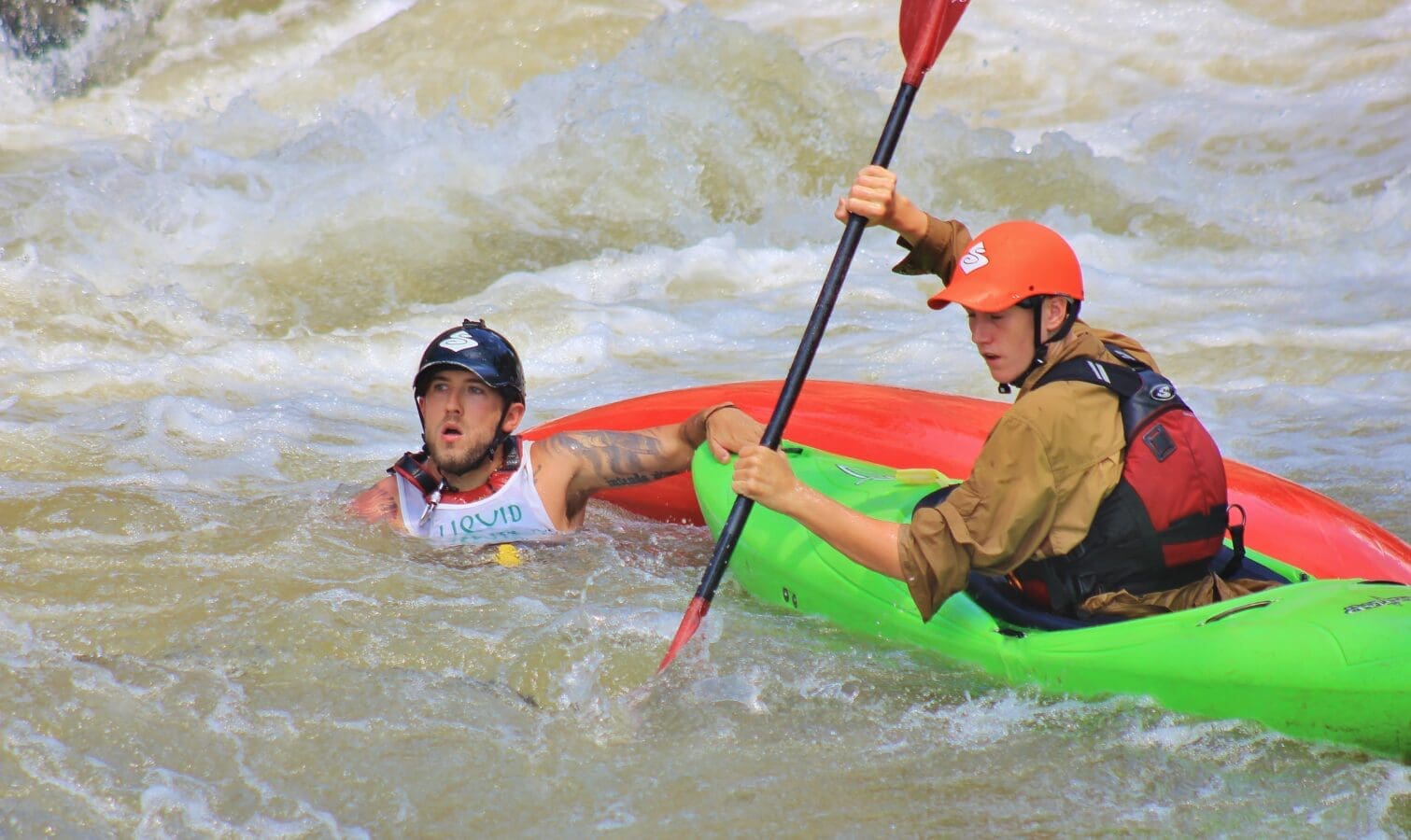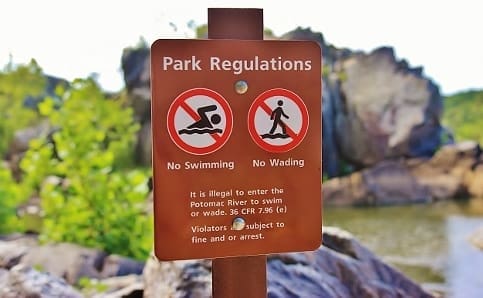
Is Swimming Illegal in the Potomac River?
During the past few years, signs have been posted in Maryland along popular hiking sections of the Potomac River near Great Falls and Mather Gorge which state that swimming and wading are illegal in the Potomac River. Swimming and wading without a personal flotation device (“PFD”) in certain types of river sections can be extremely dangerous; thus, such restrictions can be very logical. However, are these signs properly conveying the operative law in Maryland for the Potomac River? Is swimming illegal in the Potomac River? And, if so, do the laws contain any exceptions?
The short answer is: swimming and wading generally is illegal; however, if an individual is swimming or wading with a canoe/kayak/SUP and wearing a PFD, then their action is most likely legal.
To answer the question of swimming-and-wading legality in the Potomac River, the following two regulations must be reviewed: (1) the Code of Federal Regulations (“CFR”) (because sections of the Potomac River border National Parks) and (2) the Code of Maryland Regulations (“COMAR”) (because the Potomac River is within the State of Maryland).
The CFR Restriction (“Bathing, swimming, or wading”)
Federal regulations do indeed specifically restrict swimming and wading in the Potomac River. The CFR clearly states that “Bathing, swimming or wading in the Tidal Basin, the Chesapeake and Ohio Canal, or Rock Creek, or entering from other areas covered by this section the Potomac River . . . except for the purpose of saving a drowning person, is prohibited.” (36 CFR 7.96(e)).
The “areas covered” by the CFR Restriction are the National Capital Region Parks.
Thus, entering the Potomac River for “[b]athing, swimming, or wading” from any National Capital Region Park (which includes the C&O Canal and Great Falls Park) is restricted.
The CFR Exemption (“personal flotation devices”)
However, the Federal regulations also contemplate that boaters wearing PFDs might require specific regulations or laws that could conflict with CFR regulations. Thus, the CFR creates the following exemption for all of its regulations: “The States are exempted from preemption by Federal regulations when establishing, continuing in effect, or enforcing State laws and regulations on the wearing or the carriage of personal flotation devices directly related to the following subject areas within the jurisdictional boundaries of the State: (a) Children on board any vessel; (b) Operating a canoe or kayak; (c) Operating a sailboard; and (d) Operating a personal watercraft.” (33 CFR 175.5).
Therefore, if the State of Maryland has established laws or regulations regarding the “wearing or the carriage of personal flotation devices” for the Potomac River related to the subject areas/boats listed in the CFR Exemption, then those state laws or regulations will trump the CFR Restriction (or any CFR regulation).
The COMAR Restriction (“recreational use”)
Like the CFR Restriction, the State of Maryland does indeed restrict swimming and wading in the Potomac River. The COMAR specifically defines, “recreational use” as “activities on the Potomac River, including swimming, bathing, wading, diving, tubing, rafting, and other uses involving contact with the water.” (COMAR 08.06.01.02B(2)(a)). Accordingly, the COMAR makes the following restriction: “A person may not enter the Potomac River for the purpose of recreational use” in the following two areas: (a) from “200 yards above the crest of Aqueduct Dam to . . . upstream of a line beginning at the base of Stubblefield Falls” and (b) between “100 yards above the crest of Dam No. 1 . . . and upstream of the Maryland-District Columbia line.” (COMAR 08.06.01.03).
Thus, in these Potomac River areas (which encompass most of the River between Great Falls and the Maryland/Washington, D.C. line), swimming and wading as a “recreational use” are prohibited.
The COMAR Exemption (“Boating” while wearing a “flotation device”)
Additionally, as exactly anticipated by the CFR Exemption, the State of Maryland regulates activities regarding boating with a PFD. And the exemption below trumps and supersedes any CFR-swimming/wading prohibition because it addresses wearing a PFD related to CFR-Exemption-listed subjects/boats — “vessels” as defined in COMAR 08.06.01.02B(3).
- First, “recreational use” (as prohibited in the COMAR Restriction) “does not include” “Boating, if each person involved is wearing the U.S. Coast Guard approved flotation device required by law or regulation.” (COMAR 08.06.01.02B(2)(b)).
- Second, “Boating” is defined as “any recreational or other use of the Potomac River involving a vessel, including swimming or wading in association with a vessel.” (COMAR 08.06.01.02B(1)).
- Third, as described in a prior article within this Law Blog, anyone using a “vessel” on the Potomac River from Great Falls to Washington, D.C. is “required” to wear a PFD. (COMAR 08.18.01.08).
 Thus, “swimming or wading” by a boater associated “with a vessel” and wearing a “flotation device” between Great Falls and Washington, D.C. is not prohibited by the COMAR Restriction or CFR Restriction.
Thus, “swimming or wading” by a boater associated “with a vessel” and wearing a “flotation device” between Great Falls and Washington, D.C. is not prohibited by the COMAR Restriction or CFR Restriction.
Conclusion
Swimming or wading is legally restricted in the Potomac River by entering the River (a) though any National Capital Region Park (via CFR) and (b) in most areas between Great Falls and the Maryland/Washington, D.C. line (via COMAR).
However, swimming or wading in any section of the Potomac River is not illegal when the individual (1) is “wearing” a PFD while involved with a “vessel” and (2) is “associated with a vessel” (vessel includes kayaks, canoes, and multiple-chambered rafts).
Longman & Van Grack regularly advises clients regarding sports and recreation legal issues within our Sports and Recreation Law Practice. In fact, Longman & Van Grack attorney Adam Van Grack has not only represented sports and recreation entities, but has also been a member of the boards of several sports safety and Olympic training nonprofits. Call us at (301) 291-5027 if you have any further questions or if you think we can help you out.

